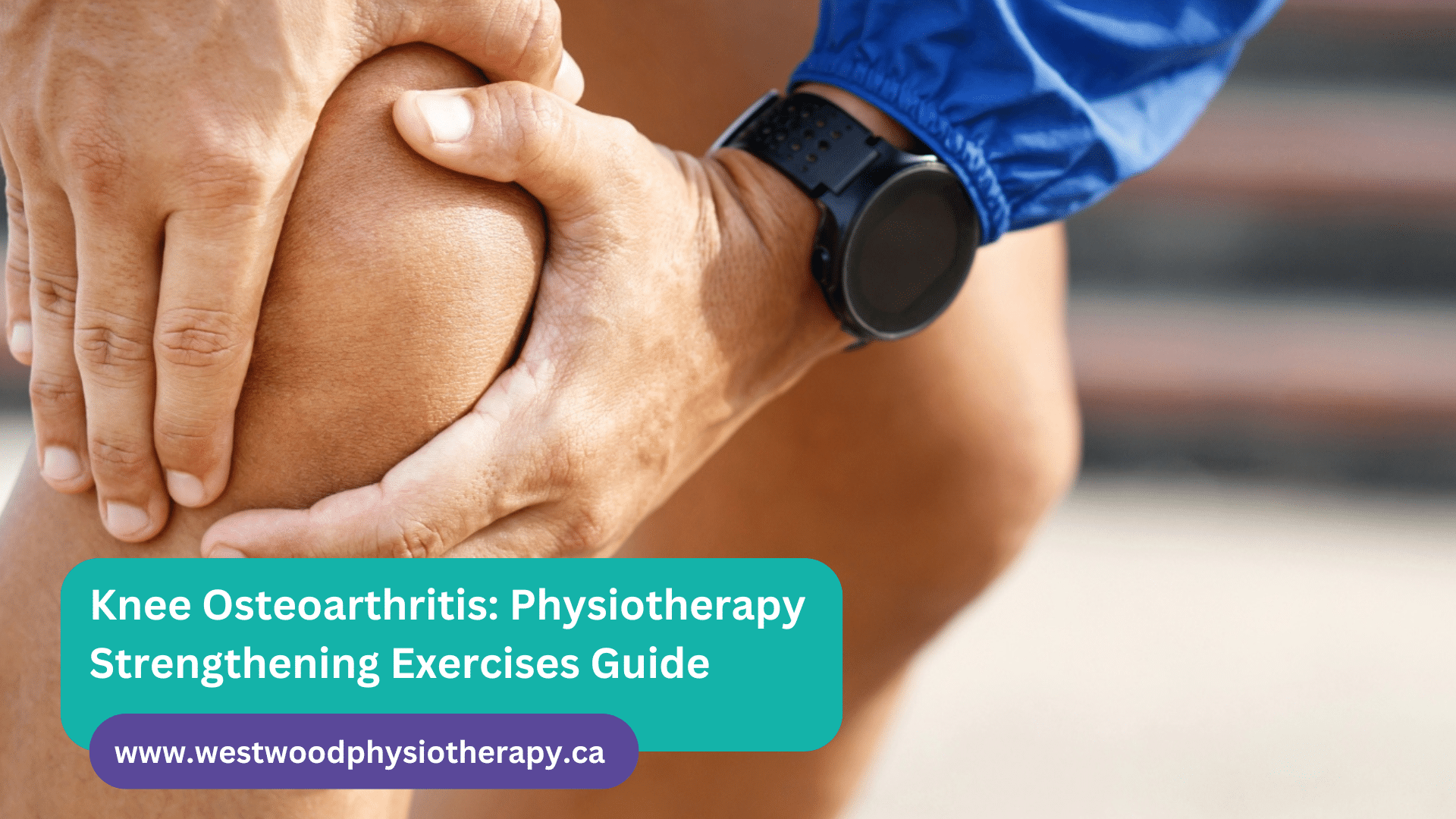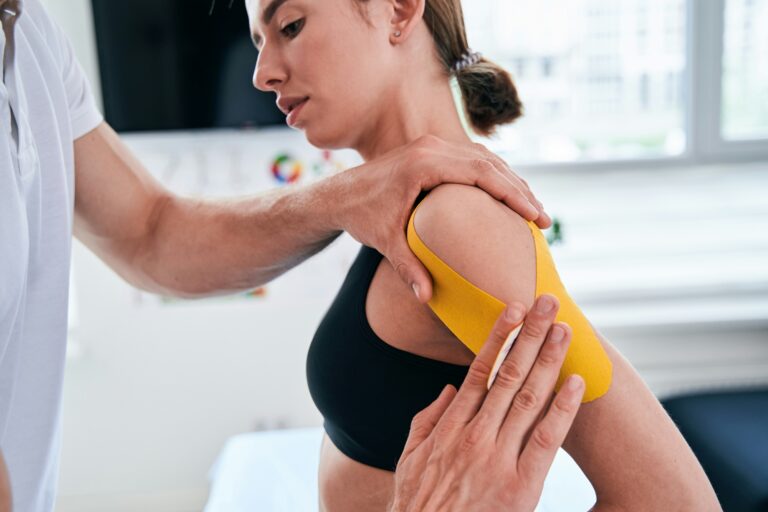Knee Osteoarthritis: Physiotherapy Strengthening Exercises Guide
Over 4.6 million Canadians are living with osteoarthritis, with the knee being one of the most commonly affected joints (Canadian Institute for Health Information, 2022). If you’re dealing with knee osteoarthritis, you know how the stiffness and pain can make simple activities like walking or climbing stairs feel impossible. The good news? You don’t have to accept this as your new normal.
Physiotherapy, especially strengthening exercises, can significantly reduce knee osteoarthritis pain while improving your joint mobility and overall quality of life. Research shows that targeted exercises help support the muscles around your knee joint, taking pressure off damaged cartilage. This approach offers real relief without relying solely on medications or invasive procedures.
Your journey to better knee health starts with understanding which exercises work best and how to build them into a routine that fits your lifestyle. We’ll explore the science behind why strengthening exercises are so effective for osteoarthritis treatment and guide you through creating a personalized exercise plan that delivers lasting results.
How Strengthening Exercises Relieve Knee Osteoarthritis Pain
Strengthening exercises work by building muscle support around your knee joint and reducing the mechanical stress on damaged cartilage. These targeted movements also improve blood flow to the area and help your joint move more smoothly through its full range of motion.
Benefits of Strengthening Exercises for Knee Pain
Your quadriceps muscles act like natural shock absorbers for your knee joint. When these muscles are strong, they take pressure off the worn cartilage in your knee.
Key muscle groups that support your knee include:
- Quadriceps (front of thigh)
- Hamstrings (back of thigh)
- Glutes (buttocks)
- Calf muscles
Strong muscles around your knee create better joint stability. This means less wobbling and grinding when you walk or climb stairs.
Your pain often comes from bone-on-bone contact when cartilage wears away. Muscle strengthening creates a protective cushion effect that reduces this painful friction.
Direct benefits you’ll notice:
- Less morning stiffness
- Easier stair climbing
- Reduced pain during daily activities
- Better balance and stability
The exercises don’t just mask pain – they address the root mechanical problems. Your stronger muscles take on more of the load that your damaged cartilage can’t handle anymore.
Improving Joint Mobility Through Physiotherapy
Stiff joints move in limited, jerky patterns that create more wear and tear. Your physiotherapist targets this problem with specific mobility exercises.
Range of motion improvements happen through:
- Gentle stretching exercises
- Joint mobilization techniques
- Progressive movement patterns
- Flexibility training
You’ll work on both active and passive movements. Active exercises involve you moving your knee through its range. Passive techniques involve your therapist moving the joint for you.
Your synovial fluid acts like oil in your knee joint. Movement exercises help distribute this fluid more evenly across cartilage surfaces. Better lubrication means smoother, less painful movement.
Mobility exercises focus on:
- Knee bending (flexion)
- Knee straightening (extension)
- Weight-bearing movements
- Functional activities like squatting
Your improved mobility directly reduces pain because your joint moves more naturally. Smooth movement patterns put less stress on damaged areas of cartilage.
Role of Physiotherapy in Pain Management for Osteoarthritis
Your physiotherapist creates a complete pain management plan that goes beyond just exercises. This approach addresses both immediate pain relief and long-term joint health.
Pain management techniques include:
- Exercise therapy – builds strength and mobility
- Manual therapy – hands-on joint mobilization
- Education – proper movement patterns
- Activity modification – safer ways to do daily tasks
Heat and cold therapy often complement your exercise program. Your therapist will show you when to use each method for maximum pain relief.
You’ll learn specific techniques to manage pain flares. These might include gentle stretches, positioning strategies, or modified activities during tough days.
Your treatment plan typically includes:
- Initial assessment and goal setting
- Progressive exercise program
- Pain monitoring and adjustment
- Home exercise instruction
- Activity modification training
The goal isn’t just reducing your current pain. Your physiotherapist helps prevent future joint damage by teaching you movement patterns that protect your knees during daily activities.
Developing an Effective Knee Osteoarthritis Exercise Routine
Building a proper exercise routine requires specific knee strengthening movements, safe progression methods, and practical strategies to maintain your daily practice. The right approach combines targeted muscle building with careful attention to your body’s signals.
Key Knee Strengthening Exercises to Try
Start with these proven exercises that target the muscles around your knee joint. Straight leg raises work your quadriceps without putting stress on your knee.
Lie on your back with one leg bent. Keep the other leg straight and lift it 6 inches off the ground. Hold for 5 seconds and lower slowly.
Wall sits strengthen your thighs and glutes effectively. Stand with your back against a wall and slide down until your thighs are parallel to the floor.
Hold this position for 10-30 seconds. Your knees should stay directly over your ankles.
Step-ups improve functional strength for daily activities. Use a sturdy step that’s 4-6 inches high initially.
Step up with your affected leg first. Step down slowly with control. Start with 5-10 repetitions per leg.
Calf raises support your knee by strengthening your lower legs. Stand behind a chair for balance and rise up onto your toes.
Hold for 2 seconds at the top. Lower slowly and repeat 10-15 times.
Incorporating Rehabilitation Exercises Safely
Begin every session with a 5-10 minute warm-up. Walk in place or do gentle marching movements to increase blood flow to your joints.
Start with low resistance and focus on proper form first. You can always add difficulty later as your strength improves.
Listen to your body’s signals during each exercise. Mild muscle fatigue is normal, but sharp knee pain means you should stop immediately.
Progress gradually by adding repetitions before increasing resistance. Add 2-3 more reps each week when exercises become easier.
Cool down with gentle stretching after your workout. Hold each stretch for 15-30 seconds without bouncing.
Apply ice to your knee for 10-15 minutes if you experience swelling after exercising. This helps reduce inflammation naturally.
Tips for Staying Consistent With Your Exercise Plan
Schedule your exercises at the same time each day. Morning routines often work best because you’re less likely to skip them.
Track your progress in a simple notebook or phone app. Write down which exercises you completed and how many reps you did.
Start small with just 10-15 minutes per day. Building the habit matters more than perfect performance initially!
Find an exercise buddy or join a support group for people with knee osteoarthritis. Social support makes a huge difference in long-term success.
Prepare backup plans for challenging days. Keep a list of 3-5 gentle exercises you can do when your knee feels stiff or sore.
Set realistic weekly goals rather than daily perfection. Aim for 4-5 exercise sessions per week instead of trying to be perfect every single day.
Conclusion
Physiotherapy offers real hope for managing knee osteoarthritis pain. The strengthening exercises we’ve covered can make a meaningful difference in your daily life—helping reduce stiffness, improve mobility, and restore confidence in movement. But at Westwood Physiotherapy, our approach goes beyond just muscle strengthening.
We recognize that every knee is part of a larger system. That’s why we incorporate neuromuscular training and manual therapy techniques not only for the knee itself, but also for related areas like the hip and low back. By addressing how your whole body moves, we can relieve pressure on the knee joint and improve function more effectively.
Equally important is patient education. Understanding how to protect your joints during daily activities—whether it’s lifting, bending, or simply walking—empowers you to manage osteoarthritis with more confidence.
Our care also takes a comprehensive focus, targeting more than just your leg muscles. We emphasize core stability and proper alignment, ensuring your joints are supported during both rest and movement. This combination of functional training, improved activity tolerance, and strength building creates lasting changes that extend far beyond the treatment room.
And for patients with knee osteoarthritis, we’re proud to offer the GLA:D Canada Program—a specialized, evidence-based protocol with proven outcomes. Not all clinics provide this program, but we believe it’s a powerful tool for helping our patients reduce pain, improve function, and live more fully.
Your journey with knee osteoarthritis doesn’t have to mean giving up the activities you love. With a treatment plan designed around your body and your goals, we can help you move with less pain and more freedom. Take the first step toward better knee health today—our team at Westwood Physiotherapy in Guelph and Tavistock is ready to guide you every step of the way.







